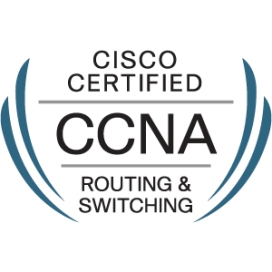As you can imagine, there are many aspects you will need to take into consideration when putting together a network, specially if dealing with a large corporate network. It’s simply not the same, configuring a network for a small office with 5 employees than configuring a network for a corporate branch with 5000 employees.
Some of the concepts we need to consider when designing a LAN are very straight forward like physical space, cabling, power source, static IP addressing, etc. and some are more complex like flexibility, expandability, security, routing protocol implementation, dynamic IP addressing, IP sub-netting, etc. Basically, the complexity of a network is directly proportional to the size of the network itself.
Luckily, we are getting ready for the CCNA, and its scope states; “…skills required to install, operate, and troubleshoot small to medium-size enterprise branch networks”, so let’s keep this in mind.

The picture above shows the most simple and therefor the easiest network there is; two PCs connected to each other through a crossover cable sharing files, that’s it.
A good scenario for the network above will be a small business that has a PC at the front desk getting prices and stock availability from the PC in the back office, for example.
Now, let’s say that business is good and we start printing our own forms and other printing goods, we’ll need a printer then. No problem, we can add a printer to this network without having to buy any additional network equipment. All we need to do is connect the printer to one of the PCs and share it so the other PC can access it as if it was directly attached. By the way, sharing is the key point of a network, a network is put in use for that purpose; sharing resources.
After a few months of growth, we decide to hire an employee for inventory tracking. We will need to provide this employee with a PC of its own somewhere in the stock room, right?
In this case, we’ll have to implement some sort of centralized connecting point so we can connect this 3rd PC, enter the Hub. A Hub is perfect for this scenario because it’s an economical solution, the network is very small and it’s easy to install. Even today, for any scenario like this one, a Hub will get the job done and this is the main reason why you can still come across a Hub or two implemented in modern networks.
So, with the implementation of a central connecting point (the Hub in this case), we can even move the printer from where it was to somewhere equidistant to all three areas; front desk, back office and stock room (employees have been complaining about having to walk too long of a distance to get their print outs).
Further more, there is another device we need to add to the network right away without having to wait for our business to grow. In modern days, a business needs to be able to connect to the Internet right away, so we’ll need a router as well, let’s do this:

Our network is beginning to get some color now, and we only just added two additional network devices. By implementing a Hub we’ve added flexibility, because we were able to move the printer from where it was before to facilitate its physical accessibility, and we’ve also added a certain degree of expandability because, even though Hubs are fairly low on port density (6 ports on this Hub), we can still add one more device to our network if we need to do so in the future. Also, everyone in the office is able to access the Internet through the router we’ve added.
OK, a year has gone by and our basic network is not able to keep up any longer. Since our first employee for the stock room, we’ve hired 16 more employees; 6 for the back office, 4 for the front desk and 6 for the stock r… oh no wait, it is a warehouse now. :O)
We will have to add three more Hubs to accommodate all the users, but the amount of traffic generated by 20 users will be too much for Hubs. Due to the large amount of Unicast, Multicast and Broacast messages, we will start having to many collisions (remember that all the ports on a Hub belong to the same collision domain) and the network might start slowing down a bit. We can still use Hubs, but we’ll need a device that breaks up the collision domains, enter the Bridge.
A Bridge was used for two reasons; to connect two different types of networks (i.e. Ethernet and Token-Ring) and/or to break up collision domains.
Note: Please remember that Hubs are almost obsolete and Bridges are completely obsolete. I am implementing this scenario only to demonstrate the devices’ purpose and functionality. In this particular scenario, a single Switch could’ve replaced all the Hubs and Bridges. We’ll see how just ahead.
As you can see in the picture above, things are starting to get a bit crowded. We needed to add 3 more Hubs to accommodate our employees’ needs, and we had to use a Bridge to break in two smaller collision domains, the single domain that would’ve been created otherwise.
Note: If you need more info on Collision Domains, please read my post “Broadcast and Collision Domains” here in my blog.

About 25+ years ago, the above setup was pretty common because the Switch had not been introduced yet. Networks, at the beginning, started being fairly small and therefor simple, but as they became more and more popular, they also started getting larger and larger and Hubs were no longer able to handle the pressure, sort of speak.
Let’s put together the previous setup but this time using a modern Switch:

Now, the above setup is far from perfect but it is much better, performance wise, then the previous setup with all the Hubs and the Bridge. In this case we have 16 devices (representing 20 users in our scenario), therefor there are a total of 16 collision domains which is much better than two, as we had in the previous configuration.
But that is not all, collisions are virtually impossible on a Switch because each port on a Switch works on Full-Duplex mode. This means that each port is able to send and receive information at the same time due to the fact that it uses (inside the UTP cable) one wire to transmit and another, separate wire to receive, therefor collision are not possible. If there are collisions occurring on a Switch, the port is provably configured to run in Half-Duplex instead of Full-Duplex.
Also, performance was improved greatly because, as we know, Switches are intelligent devices able to make forwarding decisions, so they will send each frame directly to where it needs to go, instead of just replicating it out of every port as a Hub does.
So our business has grown exponentially for 3 years now, and it is time to reconfigure our network accordingly. We still have the front desk and the warehouse, but our back office has not only grown, it has also been split up into 3 different departments; Accounting, Human Resources and Legal.

We can definitely say that we’ve come a long way! Let’s see what we did now, and remember that there is always a better way to do things… it all depends on the budget I guess :O)
Here we have a network with 100+ users distributed in 5 Vlans, and a Router (R1, which is the Active router at the moment) configured to route traffic between the Vlans. This network is redundant, as you can see by the double links connecting the multiple Switches. There is even redundancy at Layer 3 with R1 and R2 configured for Hot-Standby Router Protocol (HSRP), which is a protocol used to ensure that there will be a Router, ready to take over, in case the main router fails.
It goes like this; If a link goes down, Spanning Tree Protocol (STP) will unblock another link and keep traffic going, if either SW1 or SW2 goes down, the other Switch will start receiving the traffic. If R1 (the HSRP Active router) goes down, no body will lose Internet access because R2 will take over for R1.
Lastly, if one of the department Switches (i.e. SW_HR) goes down, there is a spare switch ready to replace whichever Switch has failed. Redundancy is a great thing!
OK, please keep in mind that this article is meant to be used as a basic guide to “Select the components required to meet a given network specification” within the CCNA scope. There are many different configurations we can put together and still come up to the same or even better results. Some of this configurations will be considered just plain wrong (even if the requirements are still met) and others will be considered as a “different way to go”.
If after reading this article you come up with a better understanding of how to put a network together to serve a specific purpose, then the job is done. But remember that there are other ways to go, especially if you implement other types of hardware and advance features like Layer 3 Switches, Vlans, Access Lists for security, VoIP, Wireless technology, etc.



Fantastic Article – I have a better understanding now on network design – thank you 🙂
LikeLike
Thanks AP! Let me know if I can help you further.
LikeLike
Your welcome. Please keep those articles coming as I am really enjoying reading all your articles 🙂
LikeLiked by 1 person